What offers better video quality in general, capture cards or DVD recorders.
I would be looking at capture cards that do the MPEG encoding on the fly (i.e. the Hauppauge cards, for example) vs. DVD recorders that are mentioned often here (e.g. JVC DR-M100S, Toshiba D-R4, etc.)
Source would typically be VHS, or less often S-VHS with a high quality JVC VCR (HR-S9800U). Again, key is direct to disc encoding and quality of video.
Thanks in advance for your assistance.
+ Reply to Thread
Results 1 to 27 of 27
-
-
How much editing and fancy authoring do you want to do?
For direct to DVDR MPeg2 they are close. Computers can record higher qulaity in a two step process.Recommends: Kiva.org - Loans that change lives.
http://www.kiva.org/about -
I'm strictly looking at video quality on a direct transfer (i.e. no fancy authoring). Would the DVD recorder win this?
Would a 2 step process yield significantly higher quality? By 2 step, I imagine you're referring to something like the ADVC-100. How long would that process take? e.g for a 1 hour tape, 1 hour to transfer to DV, and then how long approx to convert to MPEG and burn? vs. how long does finalize take on a DVD recorder like the JVC?
As mentioned, I have many tapes to convert and was looking for the fastest way with quality. -
great topic. My 5 cents to the subject has to do with the fact that ive been using the videooh capture device for 2 years now with excelent results. mainly from satellite to DVD (or mpeg2 format). Ive done vhs to dvd flawlessly. To tell you the truth i am quite satisfied with the unit that i do not need a dvd recorder at all...
best regards from bogota colombia -
The Hauppauge cards are great (I have the 250), but you will likely need an external TBC/Frame Synchronizer in order to avoid audio/video sync issues with them. I use a TBC-3000.
DVD Recorders have built in Frame Synchronizers, so an external unit is not required unless there are MV issues.
I would recommend that you start with a DVD Recorder. If you find that you want more flexibility, then get the Hauppauge and use the DVD Recorder as the external TBC/Frame Synchronizer. There should not be any MV issues with the Hauppauge.
I have a Toshiba HDD DVD Recorder and find it to be a very convenient way to do basic capturing, editing, and authoring. PQ is excellent. It also doubles as an excellent TBC / Frame Synchronizer / Proc Amp in passthru mode. -
If you want the best you'll need to get a DVB card for your computer. It makes a 1:1 digital copy of whatever you record.
In my opinion I think a capture card is better than a dvd recorder. With a cap card you can record at 15mbps then do all the editing out and finalize a DVD using a multi-pass process to preserve as much as possible. You can't do this on a DVD Recorder even with a hard drive. I have been using the Pioneer 633 as a 2 pass machine but I'm thinking of getting a cap card, but I'm just not sure what I should get for USB2. I'm also a little afraid of doing re-encodes because I'm not familiar with the software. The DVD recorders are much simpler to use. -
You want a JVC DR-M100S unit.Originally Posted by sctig
The filters fix pretty much all basic tape flaws (chroma noise, grain etc), and yield excellent quality DVDs from 2-4 hours long, depending on source quality and content. FR180 on the JVC is a perfect setting for most sources, and will output a DVD that looks better than your original tape.
Toshiba is pretty nice, and the higher end ones have quality filters, but the JVC beats it on VHS/S-VHS sources, no contest.
Capture cards are for more advanced work. For most needs, including those you state, the DVD recorder is easier and looks better.Want my help? Ask here! (not via PM!)
FAQs: Best Blank Discs • Best TBCs • Best VCRs for capture • Restore VHS -
Not factual. There are some Sony and the Pioneer models that I know of that can capture at around 15 Mbps (HQ+ mode) like the capture card you referred to, you can then"re-encode" (2-pass) to fit on DVD-R disc. In essence performing the same steps as a capture card in the same mode.Originally Posted by strongbad
It depends on what the user is looking for. If you are looking for something good but the shortest route to get to a finalized DVD, then DVD recorder is the way to go. For newbies who have no experience, time nor the inclination to learn more about all that can be achieved with various video tools, then DVD recorder. -
Yes I have the Pio 633 which does this but it is a pseudo 2 pass. The computer has so many softwares and filters that run true multi-pass processes. Pio and Sony do not.Originally Posted by DVWannaB
-
FR180 samples at 352. This in itself causes a loss of detail for most sources, including OTA, SVHS, and even good VHS recordings. Theory and practice demonstrate this.Originally Posted by lordsmurf
Picture quality is subjective. Some prefer the softer images obtained from filtering and noise reduction. Others prefer to preserve the source image as transparently as possible by minimizing the amount of filtering and the loss of detail.
As always, YMMV. It all depends on source, setup and expectations. -
My friend, this is quite a topic. Here is my advice. Capturing with a computer is 50% technical 50% art, then sugar coat that with luck and patience and you are good. The truth is that if you are going to put your heart & soul in your project PC is fine. See PC capturing doesn’t necessary have to be hard but it does have a learning curve. That curve will be affected by trial and error and other aspects that you might not be counting on.
If your project is something quik & easy then you should try a DVD-Recorder. The quality of the one that I have ( liteon $99 at best buy) is good up to 3hr per disk. I don't have to worry about dropped frames, conflicting applications or resources or the fact that it tied up my computer and I can't do nothing until it finish. Once you capture with your DVR you can take the DVD_RW and rip the content to edit the footage and re-author if you like. The DVD_RW can be reuse as many times you like.
Don't get me wrong. I'm not trying to put anybody down saying that DVR are better than PC captures. But for me the quick and easy project I do them DVR, TDA and I’m done....I want to believe.... -
I don't agree with any of this.Originally Posted by davideck
352x480 is at or above most traditional sources. Nothing is lost. Period. The end. There are some devices that definitely soften (Hauppage PVR cards come to mind), but that's the device's fault, not the resolution itself.
Transparent conversion is a waste for an overwhelming majority for people that would visit this site. You have old VHS tapes. WHy on earth would you want to preserve source errors like chroma noise and grain? You NEED NOT soften an image to accomplish this, and good filters (like the JVC ones) do not do it. Intelligent filters.
Mileage varies, sure, but let's keep the conversation relative to what's being asked. The poster specifically stated he wants to transfer VHS and some S-VHS. This screams loudly towards filtering. The direct-to-disc thing and on-the-fly MPEG eliminates capture cards, points to DVD recorders alone.Want my help? Ask here! (not via PM!)
FAQs: Best Blank Discs • Best TBCs • Best VCRs for capture • Restore VHS -
You're arguing against theory.Originally Posted by lordsmurf
352 sampling is the theoretical minimum required to preserve the detail possible at VHS resolution (up to 240 lines). Practical filter implementations push this requirement out beyond 352. Broadcast resolution requirements are higher. SVHS requirements are even higher. Many on this forum have verified this limitation on their capture cards / DVD Recorders. The loss of detail can be quite noticeable.
sctig also specifed an interest in the "quality of video". To me, that points towards minimizing filtering. Capturing SVHS at 352 is what screams loudly towards filtering.Originally Posted by lordsmurf -
Well, to me, "quality of video" refers to removing noise and other crap in analog tapes. Just the video, please!
Want my help? Ask here! (not via PM!)
FAQs: Best Blank Discs • Best TBCs • Best VCRs for capture • Restore VHS -
I thought the two steps referred to involve two pass encoding to mpeg. The first pass determines where the high bitrates are needed with the second pass doing most of the work.By 2 step, I imagine you're referring to something like the ADVC-100.
The card approach loses its advantage if you do this. Most recorders do this and as pointed out by a number of people above, can improve noise, provide frame synchonizing functions, etc. in hardware which cards typically do not have.I would be looking at capture cards that do the MPEG encoding on the fly
Most recorders take less than five minutes to finalize a disk if it is full. It can take longer for disks that are not full.how long does finalize take on a DVD recorder like the JVC? -
Wow... there's some really good arguments, comments and opinions here. I assume there would be another setting (besides FR180) when capturing S-VHS, as 352x480 wouldn't be enough, would it?
Hopefully this question doesn't cause any problems with davideck and lordsmurf, since there seems to be some differences of opinion there
-
Nobody ever said that's how the noise reduction was being performed. Please refrain from twisting what I say, that's childish. The LSI has some filters, and the JVC has some filters. All this "insufficient sampling" stuff refers to the machine, and is a complex topic that really need not be addressed at this time. It tends to just confuse the hell out of folks, and is why there are so many capturing myths (like "always capture highest resolution", which is stupid).Originally Posted by davideck
If you don't like 3-hour (FR180), then use 1-hour. That allocation is the same of bitrate to pixel. You can do 2-hour or 4-hour too, albeit not as perfectly (though still quite nice, it really just depends on the source content). Either way, I strongly suggest a recorder that can remove chroma noise and suppress grain. That means an LSI chipset machine, and the JVC is easily the best one. What mode you use for recording is up to you, but almost everybody will acknowledge 352x480 is fine because your source is around that anyway. For those few homemade S-VHS tapes you have, feel free to do them 1-hour or 2-hour if you think extra resolution makes a difference. It usually does not. Again, it depends on content. A camera-shot S-VHS master home movie is treated different than a off-air tv recording on a S-VHS tape.Originally Posted by sctigWant my help? Ask here! (not via PM!)
FAQs: Best Blank Discs • Best TBCs • Best VCRs for capture • Restore VHS -
When you play a VHS versus a S-VHS tape on your TV, do you think you could tell which is which in a blind test? VHS is about 250 TV lines, S-VHS is closer to 400, but some TV's have trouble displaying more than say 300-330 TV lines.when capturing S-VHS, as 352x480 wouldn't be enough, would it?
If you can see the difference, most recorders record in 720 by 480 resolution up to 2 hours. JVC documentation is not very clear about where the resolution changes are but if it is not 720 by 480 at two hours I would be surprised. You are aware of the M101S replacing the M100S?For NTSC interlaced video, the horizontal resolution is 80 (79) times the video circuitry bandwidth in megahertz, for example 3.0 MHz which is typical for a cheap TV allows about 240 lines of resolution.
The new DR-M101S DVD recorder, which stands just 2.1 inches tall, records DVDs in the DVD-RW/-R/+RW/+R formats, and is compatible in both playback and record with +R dual layer discs. Features include an HDMI output with 1080i/720p up-conversion and a DV (IEEE 1394) input, plus component video outputs. Also offered are a 16-program/one-month timer, progressive scan, six-hour recording maximum, Dolby Digital/DTS output, 1.5x playback with audio, 3D surround sound, and a slimmer, easier-to-use remote control. Compatible playback formats are DVD-Video, DVD-RW/-R/+RW/+R, CD, CD-R/RW, VCD/SVCD, JPEG and MP3.
The new DR-MV7S is a DVD/VHS recorder combo that includes all of the DR-M101S features plus a Hi-Fi VHS deck. The combo recorder, which stands just 3.1 inches tall, makes the transfer of VHS material to DVD a very simple procedure. Like the DR-M101S, the DR-MV7S offers DVD HD up-conversion, but also offers VHS HD up-conversion. Using the deck’s HDMI output, the VHS signal is up-converted to 1080i or 720p to match the resolution capability of the HD display, delivering a better quality VHS picture.
Pricing and availability:
Approximate
Model Retail Price Available
DR-M101S $229.95 May -
Sorry LS, I did not mean to twist what you were saying. I was focused on the subject of sampling and thought you were suggesting that sampling beyond 352 only served to preserve additional chroma noise and grain. My mistake.Originally Posted by lordsmurf
I agree that other factors are involved, but they do not contradict the fundamental requirements of sampling theory. The amount of detail that can be preserved is dependent upon the sampling rate. In practice, 352 sampling is not sufficient for source resolutions of 240 lines or greater.Originally Posted by lordsmurf
That's what I said. Here we agree. I think our source qualities are just different. My SVHS Camcorder tapes are beyond VHS resolution, as is the broadcast cable reception in my area.Originally Posted by lordsmurf -
Just for my information, what would the theoretical minimum be for 240 lines. I have some understanding of sampling theory in that for analog sources, sampling needs to occur at 2x the maximum frequency (Nyquist theorem). In this case, though, the analog signal is not continuous in that are 240 lines. It would seem to me in this case that if you could sample at the source resolution of 240, you would have it covered, but I'm probably missing something.Originally Posted by davideck
Could you please enlighten me on this? Or point me to an article or link that gives more info? I'm always interested in the "why?" -
Perhaps I can clarify this. The 240 lines refers to the number of lines you can see, for example by capturing a test pattern to a VHS tape. Obviously the vcr signal is analog so the Nyquist theorem applies just as you accurately described.
Here are tests of a vcr I did using a THX test pattern from the ICE AGE dvd.
The original THX test pattern from the dvd resized to 640 by 480.
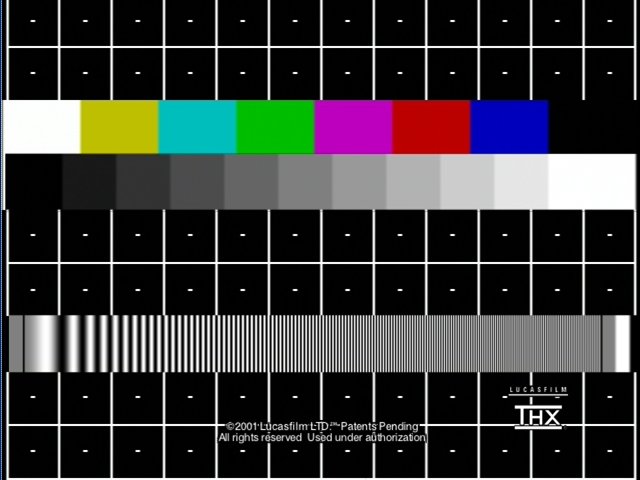
Here is what that test pattern looks like recorded to a VHS tape and played back.
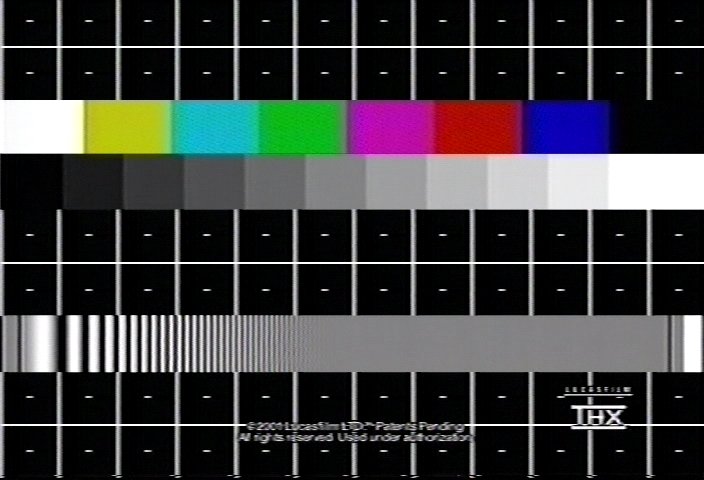
Here is an analysis of the above test pattern courtesy of edDV,
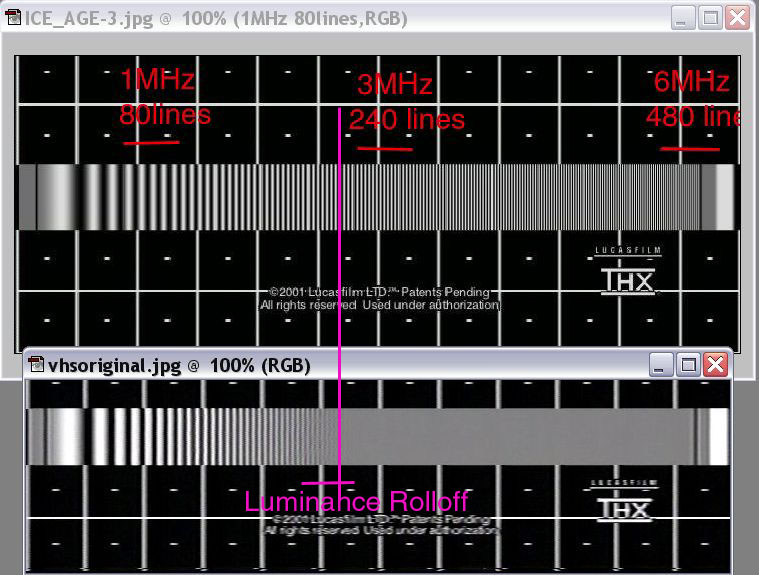
Here is what a s-video input, SP mode capture of the same test pattern to a Toshiba DR4 recorder courtesy of gshelley61 looks like,
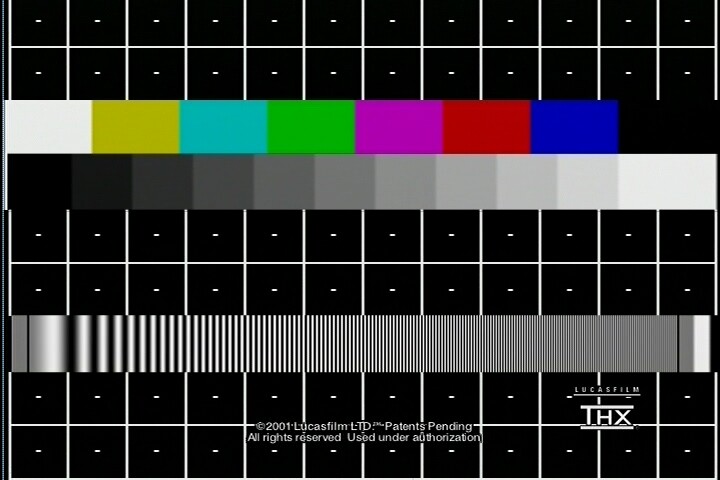
-
The number of "lines" (240, 400, etc) is simply a unit of measurement that describes the horizontal resolution (frequency bandwidth) of a video signal. These lines do not actually exist across the display in the way that raster lines exist from top to bottom. The terminology is just meant to reference horizontal resolution with respect to picture height.Originally Posted by sctig
In order to do this, the aspect ratio must be considered. A 4:3 aspect ratio must have 1.33 times as many "lines" across the display as it has from top to bottom for both dimensions to have equal resolutions. 240 lines of horizontal resolution therefore requires 240 * 1.33 = 320 "lines" across a 4:3 display.
There are "frequency sweep" test patterns that increase the frequency of a sine wave luminance signal across the screen. The frequency response (horizontal resolution) can be determined by noticing where these increasingly thinner "lines" start fading to gray. You can see this in the images above.
Note that one sine wave cycle paints a "white line" followed by a "black line", so each cycle is equivalent to 2 "lines" as defined by the terminology.
Therefore, it takes 160 sine wave cycles to paint 320 "lines" across the display, for a horizontal resolution of "240 lines". Sound confusing?
Nyquist states that you must sample each sine wave cycle at least twice, so the minimum number of samples per line for 240 lines of resolution is 160 * 2 = 320.
352 samples may seem adequate at this point, but Nyquist also assumes ideal theoretical filtering. Practical filter implementations require a higher number of samples to achieve the desired result. YMMV.
Simply stated, the theoretical minimum number of samples_per_line required = horizontal_resolution * 1.33 (for a 4:3 aspect ratio)
http://members.aol.com/ajaynejr/vidres.htm -
I think we are jumping to some conclusions here that don't match the current chipsets. Most capture chipsets (A/D) used in modern capture cards, transcoders and DVD/DVR recorders sample at 2x or 4x 13.5MHZ or 27-54Ms/s for the luminance channel and 1/2 or 1/4 that for chrominance. They do this "oversampling" to avoid the Nyquist requirement for a perfect low pass "anti-alias" analog filter at 2x the highest sampled frequency. High speed A/D converters have become cheap, while sharp bandpass analog filters (before A/D) remain very expensive (~$40-80 per component). Oversampling allows much less perfect low pass filtering pre A/D without aliasing.Originally Posted by sctig
Broadcast quality equipment will bite the cost bullet and use the more expensive low pass filters and sample at Nyquist's lower frequencies. A "perfect" capture for VHS would sample 2x the luminance cutoff frequency of 3MHz and use an expensive 3MHz lowpass filter. This would prevent capturing the chroma crosstalk noise that exists in VHS luminance above 3MHz.
Consumer capture devices are wideband with low pass upwards of 6MHz. resulting in warts and all captures from VHS but very nice quality off say a downscaled S-Video output from a HDTV cable box. This is one reason why post digital filtering can improve the look of VHS captures. DVD recorders should have a VHS input mode to kick in the optimal digital filter. You would not use that setting for a quality source.
Capture devices like the Hauppauge PVR and DVR/DVD recorders typically process the input video at full 720x480/576 and then MPeg2 encode to the selected bitrate and resolution. 352x480/576 would be filtered down during encoding. 352x240/288 would do that and simply toss one field.
Therefore, 352x480 may be bandwidth reduced, but should not show aliasing from insufficient sampling. It should also be noted that downsizing is not the same as filtering out high frequency noise. Downsizing will just downsize the noise.
PS: This graphic shows the effect of typical VCR chroma crosstalk noise on the luminance signal. Once the chroma noise is captured, it can be difficult to remove with filters without compromise.
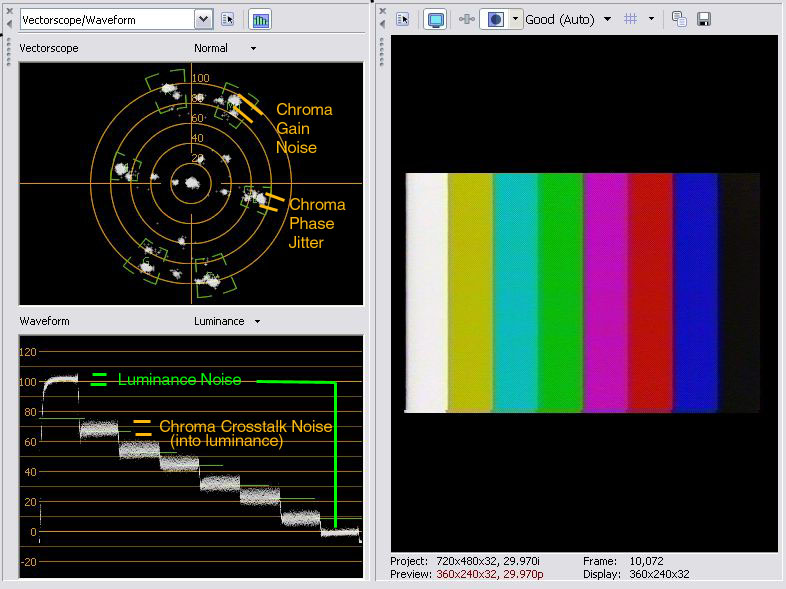
-
Thanks for taking the time to explain this further. This gives me a better understanding of the theory involved.
-
[ sctig ]
In your original post it Sounds like you really want to dub VHS and ? DVD with very good quility and if commercial ? VHS or DVD you most likely will run into copy protection.
Check ebay there are some ilo R04 units listed at less than $100. Better yet get a ilo RHD04 [with HDD] at this site and thread.
http://www.techolio.com/forums/phpBB2/viewtopic.php?t=2210
They are now discontinued [will copy all]
Look at these sites
http://www.techolio.com/forums/phpBB2/viewforum.php?f=7
http://www.normediasolutions.com/forum/viewforum.php?f=12
http://ncc2315.com/ilo/
I have 2 RHD04 and one R04. The R04 can be made into a liteOn 5005x with Allwrite
The PC is fine but has many issues if not properly done and with the proper hardware. -
Yes, back to the original post - I have had a PVR-250 for a long time. Currently with all the issues of capture, storage, and burning, I have found that for production of many discs from many tapes (say home Video8 movies) nothing beats the easy of a DVD Recorder. We like our Panasonic DMR-ES45V - has an internal time base. But for SVHS you'll probably do better to input your video from your other deck to the recorder.
I am using dual layer +R media to record 2 tapes, one on each layer. The compatability is great. Burning my own discs it was always tricky to burn something all players liked.
Read the info then go for your choice. If you go DVD Recorder, you can always return it if it's not your bag - some stores have good return policies (target.com you can return to a store in 90 days I believe).Panasonic DMR-ES45VS, keep those discs a burnin'
Similar Threads
-
Hi8 capture- Suggestions for Harddrives and Capture Cards?
By CMP1223 in forum Capturing and VCRReplies: 7Last Post: 11th Jun 2011, 00:05 -
What's new in capture cards for VHS capture?
By chowmein in forum Capturing and VCRReplies: 21Last Post: 29th Jul 2010, 09:03 -
Which of these two capture cards are better for VHS to DVD?
By nomad2224 in forum Capturing and VCRReplies: 14Last Post: 23rd Sep 2009, 10:05 -
Help with Video/Capture Cards.
By drsimp12 in forum Newbie / General discussionsReplies: 4Last Post: 7th Nov 2007, 07:05 -
Interferance on capture cards
By Signal in forum Capturing and VCRReplies: 35Last Post: 13th Sep 2007, 22:26




 Quote
Quote